

Controlling Space
One initial difference from Street Fighter is that in KOF it becomes necessary to deal with attacks coming from more unique angles due to hops. Knowing which grounded and aerial normals can cover specific angles or areas is required knowledge to best deal with the opponent's approach or to judge which approach you should attempt.
Note: the hitboxes in this section are approximations and may not be exact. They primarily demonstrate their simplified 'feel' rather.
Ground Control
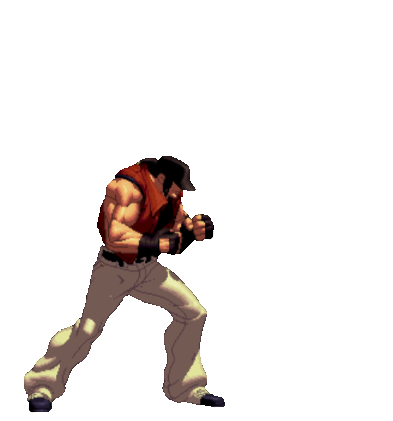
Here we see Terry standing idle at neutral, but let's quickly examine some of the common angles of approach from an oncoming hop or jump.
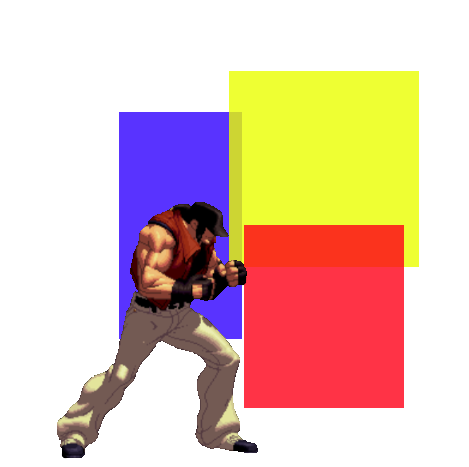
The three colored areas represent common areas of approach and thus angles that the player should want to be able to anti-air readily. Let's break them down:
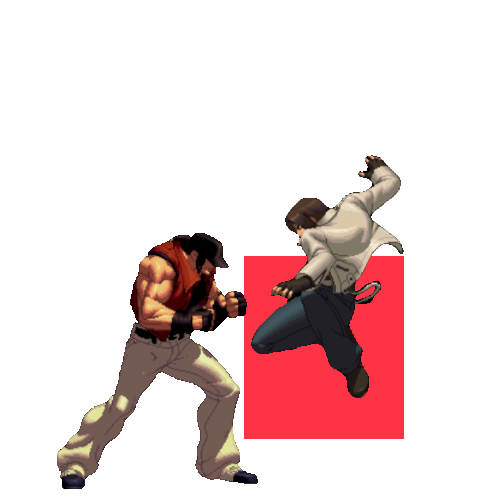
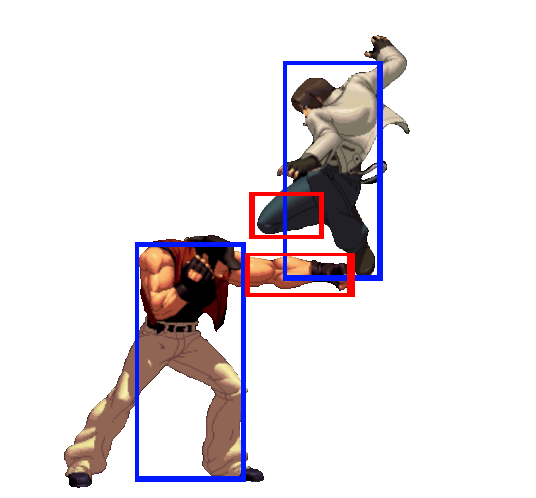
Here we have the low 'hop space' designated in red. This low area can commonly be accessed from a short or hyper hop, although it's possible to space a jump to land and attack in this low space. Having quick access to this intimate, low-to-ground zone is part of what allows KOF to have a faster offensive game.
It's also a simple area to anti-air with a Standing ![]() as demonstrated by Terry and Kyo. A standing jab is quick and places a hitbox out in front of the opponent's short trajectory. Other attacks can dominate this area (such as a typical Far/Crouching
as demonstrated by Terry and Kyo. A standing jab is quick and places a hitbox out in front of the opponent's short trajectory. Other attacks can dominate this area (such as a typical Far/Crouching ![]() or other heavy normals) but this is the quickest and safest solution to a hop.
or other heavy normals) but this is the quickest and safest solution to a hop.
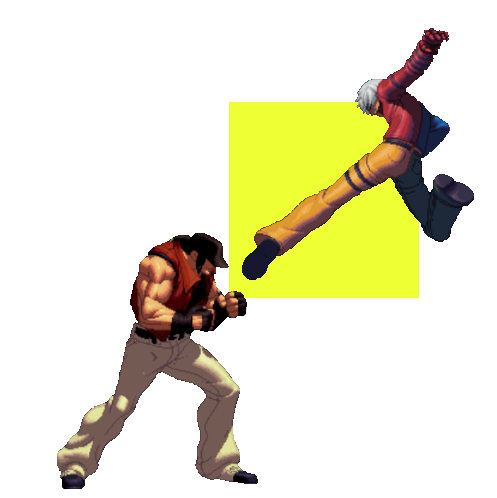
This is a difficult angle of approach to defend against and thus a great area to approach from. Defending against an aerial attack with both strong vertical and horizontal reach is difficult. Terry lacks an appropriate attack that can attack diagonally forward in this situation and so a solution (besides blocking) revolves around changing the player's positioning.
- The player has a few options against similarly-angled attacks as K's Jumping
 but most require space to work with or a risk to deal with.
but most require space to work with or a risk to deal with.
- One possibility is to hop backwards before the attack comes into range and then countering the downward attack with a horizontal air-to-air. This doesn't work if the player is cornered or if the opponent is at a large frame advantage from a previous action.
- A gutsy answer is to run forward underneath the oncoming attack and either anti-airing with an upward vertical attack.
- Likewise the player can run underneath the oncoming attack and time a Crouching
 attack to meaty the opponent while dodging the attack from behind. This can lead into a combo on success but can be countered if the opponent uses a deep vertical jumping attack or spaces the jumping attack from further out.
attack to meaty the opponent while dodging the attack from behind. This can lead into a combo on success but can be countered if the opponent uses a deep vertical jumping attack or spaces the jumping attack from further out.
- All of these techniques are demonstrated further below on this page.
- All of these techniques are demonstrated further below on this page.
- And finally the grounded player could use an invulnerable move or 'DP' through these tough jump-ins but reacting to a hop with a special is tough and requires the player to be buffering before the opponent hops. Terry is out of luck as his Rising Tackle requires a downward charge which limits the special's use outside of his wakeup.
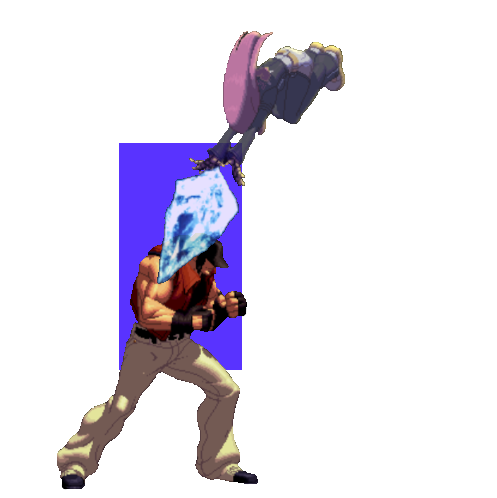
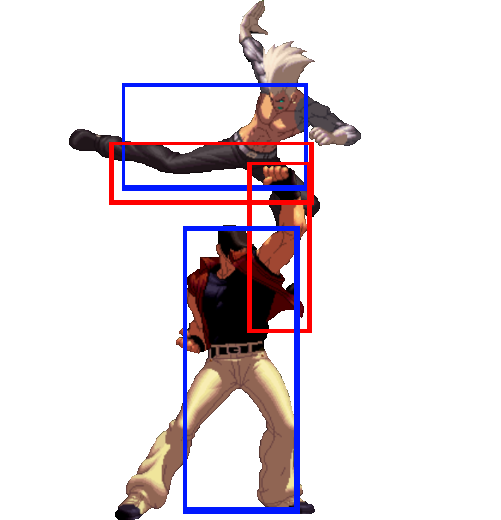
This blue area is the 'deep' or vertical angle where crossups can occur if the aerial attack registers deep enough behind the grounded player.
Vertical attacks are the anti-air solutions to these approaches. Terry's df.![]() can easily anti-air Benimaru's Jumping
can easily anti-air Benimaru's Jumping ![]() , but the more downward vertical jump-ins like Kula's Jumping
, but the more downward vertical jump-ins like Kula's Jumping ![]() are more difficult to deal with.
are more difficult to deal with.
- The main answer is to anti-air attacks like Kula J.C as fast as possible. If the opponent starts to attack preemptively to beat out an anti-air then the grounded player may be able to crouch under the attack and punish the whiffed jumping attack with a tripguard meatying crouching
 . There's also the option of running under the opponent or using an air-to-air as mentioned above.
. There's also the option of running under the opponent or using an air-to-air as mentioned above. - Some DPs or Crouching
 type uppercuts can whiff against an aerial player that travels deep into the crossup area toward Terry's back. The grounded player should walk or run forward in this situation and attempt to anti-air the opponent from behind that jumping attack's line of fire.
type uppercuts can whiff against an aerial player that travels deep into the crossup area toward Terry's back. The grounded player should walk or run forward in this situation and attempt to anti-air the opponent from behind that jumping attack's line of fire.
Let's review and take a look at all three areas again and then at all of Terry's stationary attack options:

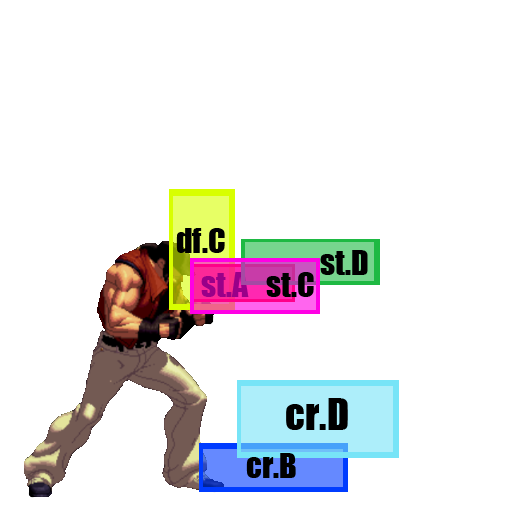
With all of Terry's main grounded attack hitboxes listed at once you can see that he lacks an attack that reaches both vertically and horizontally to control the space between the deep vertical and low hop spaces. Thankfully characters have other options to anti-air from the ground, which are listed below.
Tripguard Anti-airs

When a player commits to a jump or hop there's a recovery period when landing on the ground where the player cannot block low attacks. The grounded player can take advantage of this and attack with a Crouching ![]() or
or ![]() attack to punish the opponent.
attack to punish the opponent.
In the above picture Duo Lon is meatying Athena's early-timed Jumping ![]() attack. Usually a downward attack like hers is a strong air-to-ground attack when timed later in a jump arc but here Athena's attack ran out of active frames and is out-ranged by Duo Lon's Crouching
attack. Usually a downward attack like hers is a strong air-to-ground attack when timed later in a jump arc but here Athena's attack ran out of active frames and is out-ranged by Duo Lon's Crouching ![]() . Had Athena been closer or used a more vertically downward-hitting jumping attack then Duo Lon would have been punished with a full combo.
. Had Athena been closer or used a more vertically downward-hitting jumping attack then Duo Lon would have been punished with a full combo.
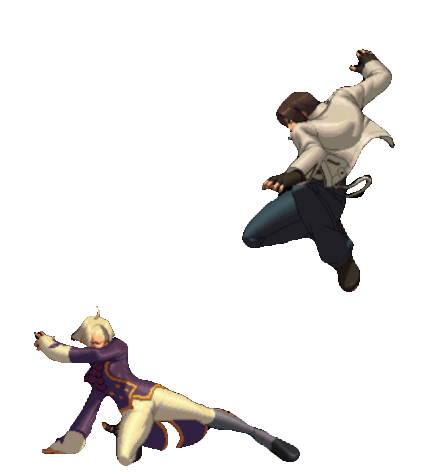
Tripguard meaties are great punishes against whiffed or crouchable jumping attacks but will outright lose to a proper 'deep' downward jumping attack.
In the above setting Kyo's vertical Jumping ![]() would hit Elizabeth out of her Crouching
would hit Elizabeth out of her Crouching ![]() for a full combo.
for a full combo.
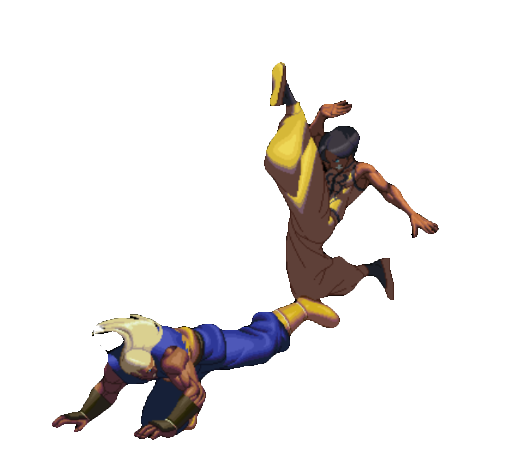
Here we can see how powerful Andy's Crouching ![]() is as an anti-air and also why horizontal and upward aerial attacks are so vulnerable from below.
is as an anti-air and also why horizontal and upward aerial attacks are so vulnerable from below.
Run-Unders
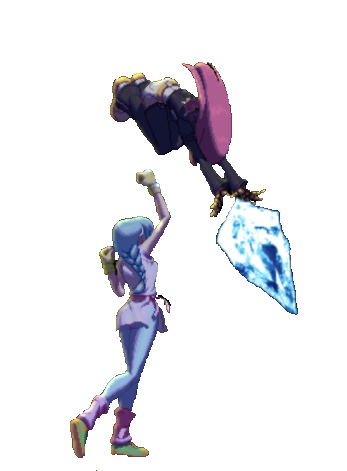
Most air-to-ground attacks have a blind spot directly underneath the character that can be exploited with attacks that reach vertically upward like Yuri's Close ![]() . If the player runs forward and can get either under or behind the opponent then the anti-air should be successful. Even a steep downward jumping attacks can be countered if the running player can get to the opponent before their attack can become active.
. If the player runs forward and can get either under or behind the opponent then the anti-air should be successful. Even a steep downward jumping attacks can be countered if the running player can get to the opponent before their attack can become active.
Running under the opponent can also be combined with a tripguard anti-air. The spacing is more demanding but if the player manages to get behind the opponent's jumping attack and use a low attack the reward can be greater than a normal anti-air.
Air Control
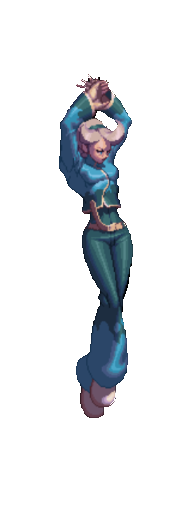
Aerial attack angles can also be categorized as on the ground. This time we'll look at Ash and a few others.
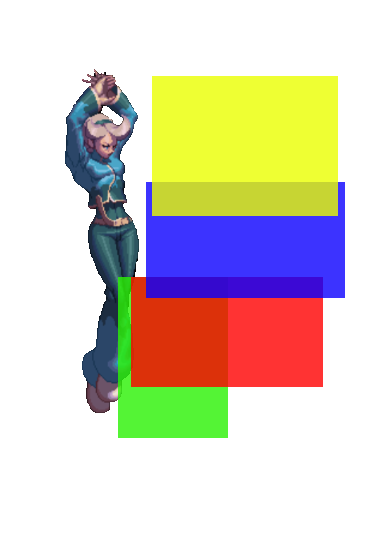
Aerial attacks primarily fall somewhere between these general outlines.
- On top is the yellow box representing the high vertical angle.
- Below is the more pure horizontal space in blue.
- The red zone enters the vertical, downward zone but still maintains extra horizontal range.
- At the bottom is the green more vertical attack zone.
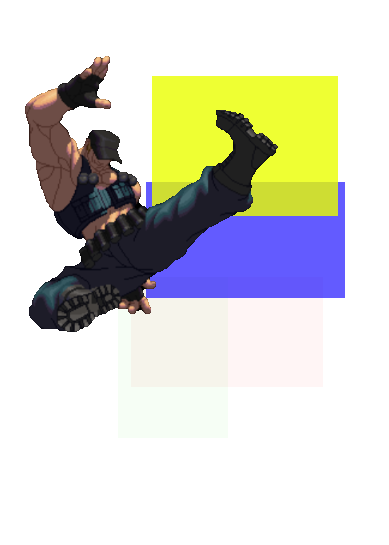
Clark's Jumping ![]() really reaches upward into that high vertical space that can air-to-air opponents above him excellently. His foot's also intermingling with the blue horizontal zone and so the attack can also air-to-air straight in front of him.
really reaches upward into that high vertical space that can air-to-air opponents above him excellently. His foot's also intermingling with the blue horizontal zone and so the attack can also air-to-air straight in front of him.
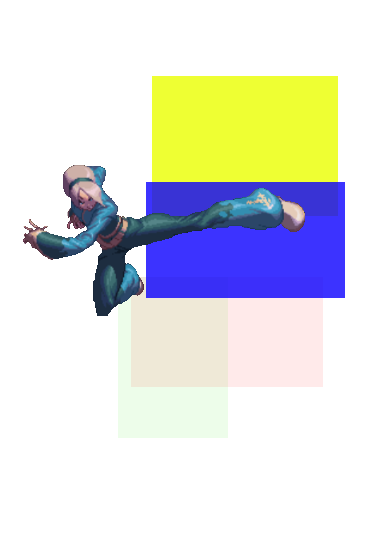
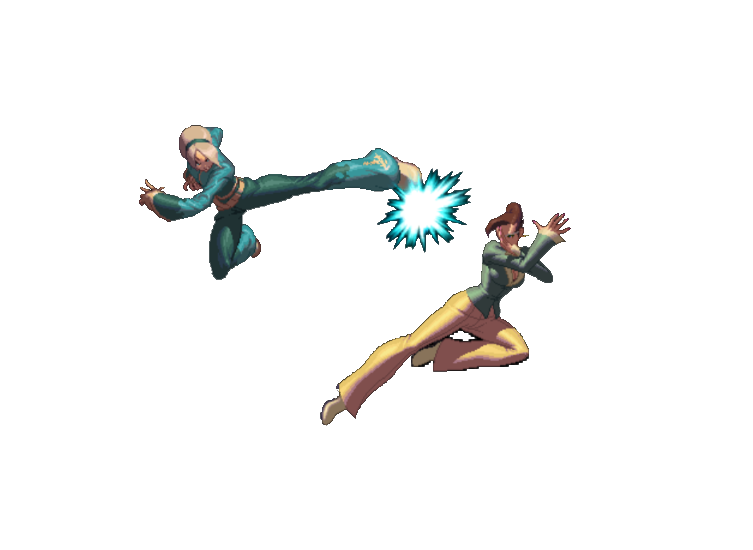
Ash's Jumping ![]() reaches primarily horizontally but slightly overlaps with the higher upward space. Attacks with this angle function best as air-to-air attacks against opponents in front of the player or slightly above or below. Downward, vertical jumping attacks will lose to these attacks unless the horizontal attack is stuffed during the startup or attacked from directly above.
reaches primarily horizontally but slightly overlaps with the higher upward space. Attacks with this angle function best as air-to-air attacks against opponents in front of the player or slightly above or below. Downward, vertical jumping attacks will lose to these attacks unless the horizontal attack is stuffed during the startup or attacked from directly above.
The effectiveness of horizontal air-to-airs should speak for itself from the image of Vice and Ash.
- While strong air-to-airs, the vertical reach is weak. These attacks are incredibly vulnerable to tripguard anti-airs if the opponent crouches.
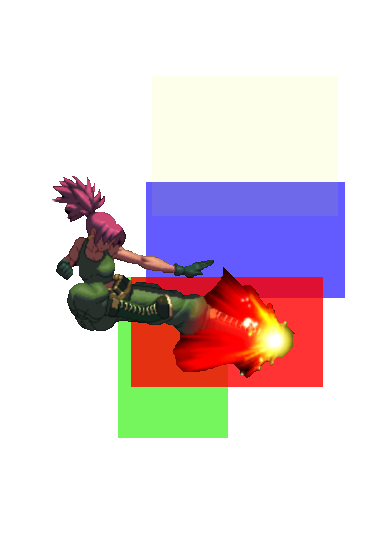
Jumping attacks that fall into the red-colored area are a strong intermediate between the horizontal and the vertical. When spaced to tip the grounded player these attacks hit deep enough to force crouchers to standblock while having the extended width that places the character's vulnerable hitbox far out of reach. Other moves like Benimaru's Jumping ![]() can additionally cross up the opponent when deep.
can additionally cross up the opponent when deep.
- One weakness of these jumping attacks is that they can be vulnerable to tripguard anti-airs if timed early. Timing the attack later creates a longer window for the grounded player to anti-air with a normal attack.
These attacks also function defensively. Neutral hopping into a similarly-angled attacks can create a barrier that will both air-to-air and hit standing or approaching opponents. The weakness of this setup is that the opponent could anti-air the jumping player with a special move or with a low attack or strong anti-air normal attack.
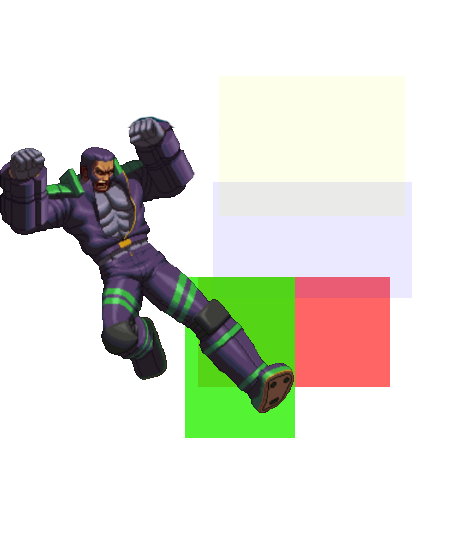
The last aerial angle to cover is the deep vertical space. These are attacks that hit deeply downward but lack that extra horizontal range; this leaves the aerial player more vulnerable to anti-air attacks while moving into position to connect against the player. One of the best ways to minimize the vulnerability when using one of these attacks is to simply save them for hops since they're the hardest aerial approaches to react to.